| MARCH 2014 |
|
4 shows in T˘ky˘ (Kabukiza, National Theatre, Shinbashi Enbuj˘), 2 shows in Ky˘to (Minamiza) and 1 tour (Classics Tour)!
|
| Kabukiza (T˘ky˘) |  |
| Dates | 2 ~ 26 March 2014 (Kokera Otoshi H˘˘sai Sangatsu ďkabuki) Opening Ceremony Phoenix Festival March Grand Kabuki |
| MatinÚe |
Koi Bikyaku Yamato ďrai (Fűin Giri) Ninin Fuji Musume |
| Evening |
Nihon Furisode Hajime (Orochi Taiji) |
| Casting |
Sakata T˘jűr˘, Band˘ Tamasabur˘, Onoe Kikugor˘, Nakamura Kichiemon, Matsumoto K˘shir˘, Nakamura Kanjaku, Nakamura Senjaku, Nakamura Baigyoku, Nakamura Kaishun, Nakamura Hashinosuke, Nakamura Shibajaku, Kataoka Takatar˘, Nakamura Kankur˘, Nakamura Shichinosuke, Kataoka Gat˘, Ichikawa Sadanji, Kataoka Hidetar˘, Nakamura Karoku, Nakamura Matagor˘, Nakamura T˘z˘, Nakamura Matsue, Nakamura Kash˘, Nakamura Kazutar˘, Nakamura Kotar˘, Nakamura Yonekichi, Onoe Ukon |
| Comments |
12th and last month celebrating the opening of the new Kabukiza within a 1-year long cycle of kokera otoshi programs. This special program is called H˘˘sai, which means Phoenix Festival. The Phoenix bird is the symbol of the Kabukiza as it is the mon of this theater. Next month programs will also be labeled as H˘˘sai. This program should have been the first month of the shűmei of Nakamura Utaemon VII and Nakamura Fukusuke X but it was postponed as the former actor was on sick leave.
|
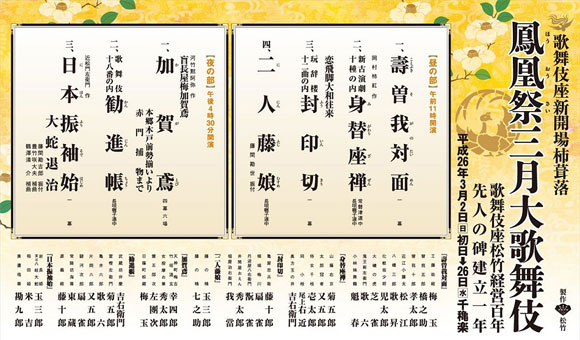 |
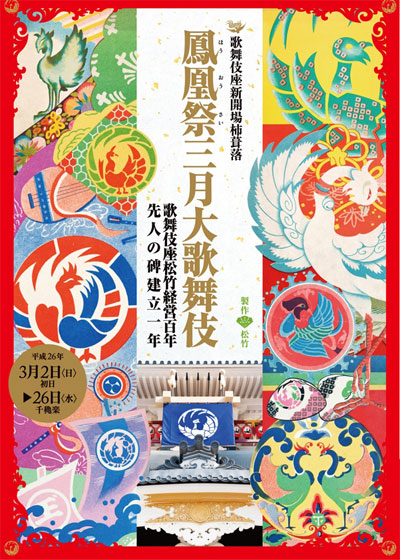 |
| National Theatre (T˘ky˘) |
| Dates | 3 ~ 26 March 2014 |
| Program | |
| Casting |
Nakamura Tokiz˘, Nakamura Kinnosuke, Band˘ Yajűr˘, Band˘ Shűch˘, Ichikawa Omez˘, Kamimura Kichiya, Arashi Kitsusabur˘, Nakamura Mantar˘, Nakamura Hayato |
| Comments |
Nakamura Tokiz˘ plays for the first time the role of Otomi, the leading role of the drama "Kirare Otomi".
|
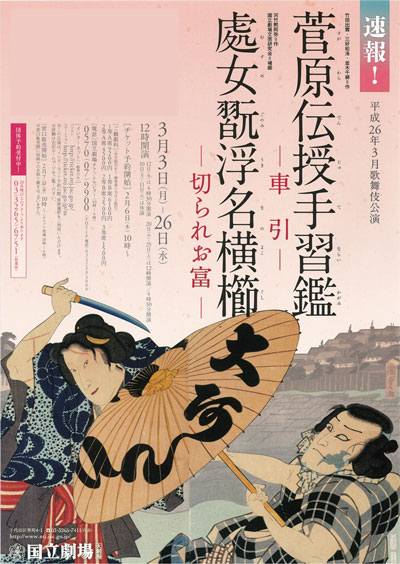 |
|
|||
| Dates | 2 ~ 26 March 2014 (Sangatsu Hanagata Kabuki) March Young Actors Kabuki |
||
| MatinÚe |
Yowa Nasake Ukina no Yokogushi (Kirare Yosa)
|
||
| Evening |
|
||
| Casting |
Onoe Kikunosuke, Onoe Sh˘roku, Ichikawa Danz˘, Band˘ Hikosabur˘, Ichimura Manjir˘, Kawarasaki Gonjűr˘, Nakamura Baishi, Onoe Matsuya, Band˘ Kamesabur˘, Band˘ Kametoshi, Kataoka Matsunosuke, Band˘ Minosuke, ďtani Hiromatsu, Band˘ Shingo, Ichimura Takematsu |
||
| Comments |
A March program at the Minamiza with young actors. The spectacular drama "Gohiiki Kanjinch˘" has not been staged in Ky˘to between June 1945 and February 2014!
|
||
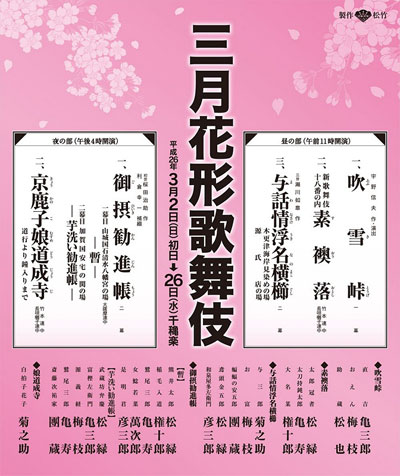 |
| Shinbashi Enbuj˘ (T˘ky˘) |
| Dates | 5 ~ 29 March 2014 (SűpÔ Kabuki Sekando) Super Kabuki II |
| Program |
Sora o Kizamu Mono |
| Casting |
Ichikawa Ennosuke, Ichikawa Monnosuke, Ichikawa Ukon, Ichikawa Emiya, Ichikawa Emisabur˘, Ichikawa Juen, Ichikawa K˘tar˘, Ichikawa Shun'en, Ichikawa En'ya, Fukushi Seiji, Asano Kazuyuki, Sasaki Kuranosuke |
| Comments |
"Sora o Kizamu Mono" means the Man who sculptures the Sky. In 2014 Ichikawa Ennosuke IV starts on forming a theatrical space which has never existed before. It is called SűpÔ Kabuki Sekando (the second generation of SűpÔ Kabuki). He succeeds to the spirit of Super Kabuki (SűpÔ Kabuki) which was originated by his uncle Ichikawa Ennosuke III and creates a completely new theatrical space with talented actors who represent the present theatrical world. He performs with actors of modern plays in addition to the Kabuki actors who appeared on the stage of Super Kabuki. This play is written and directed by a young and spirited dramatist Maekawa Tomohiro. The scene is set in ancient Japan. A talented young sculptor of Buddhist images named Towa (performed by Ichikawa Ennosuke) lives in a mountain village. He is irritated at Buddhism which can save neither the villagers' living nor his ailing mother. Kazuma (performed by Sasaki Kuranosuke), a friend of Towa from his childhood, worries about the villagers who are troubled by poor crop. He goes to the capital and enters government service to improve their lives. Towa's mother dies. Towa fights against an official from the capital and has to leave the village. He is imprisoned, but matures as he associates with robbers. Kazuma on the other hand feels himself helpless as a lower-level official, though he has gone to the capital. Towa and Kazuma went their own ways according to their own thought. The day has come when their courses of life cross and they happen to meet again. |
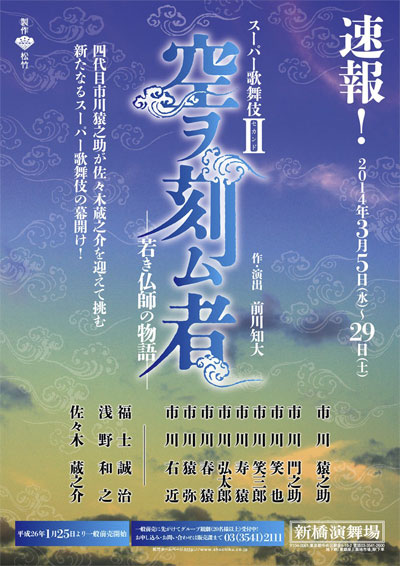 |
| Classics Tour | |
| Dates | 6 ~ 25 March 2013 (Koten he no Izanai) Invitation to the Classics |
| Program |
Opening Talk Shakky˘ (N˘) |
| Casting | |
| Comments |
An original tour in 7 cities (with a 4-day stay at the Yachiyoza from the 6th to the 10th of March 2014), which mixes talk, N˘ and Kabuki. The second item is the N˘ drama "Shakky˘", performed by Kanze Yoshimasa and Kamei Tadao. The third item is the Kabuki dance-drama "Renjishi". The opening talk is done by the young Kabuki star Ichikawa Ebiz˘.
|
|
|
| Contact | Main | Top | Updates | Actors | Plays | Playwrights | Programs | Links | FAQ | Glossary | Chronology | Illustrations | Prints | Characters | Derivatives | Theaters | Coming soon | News |